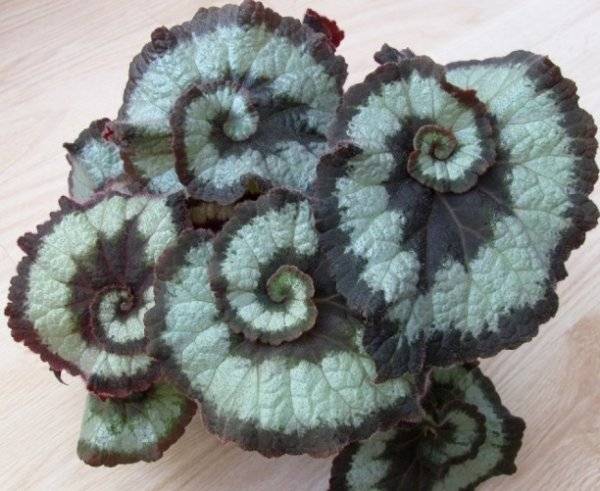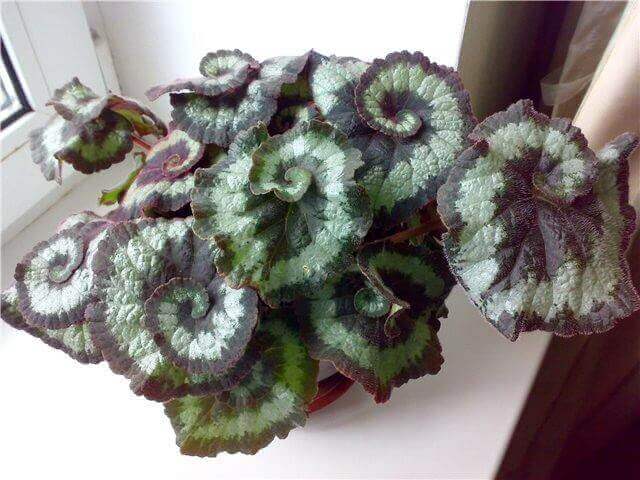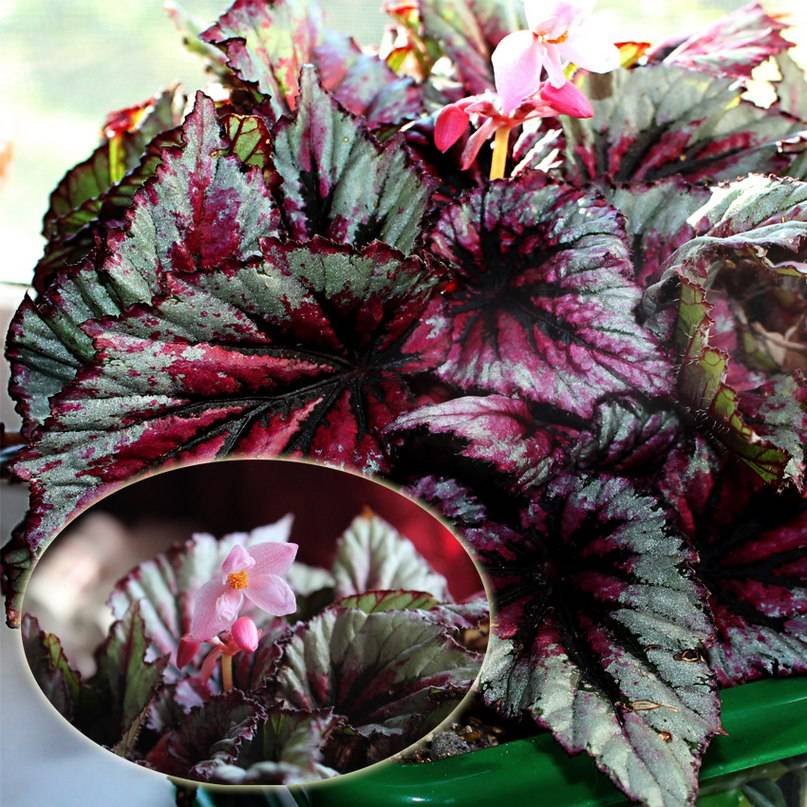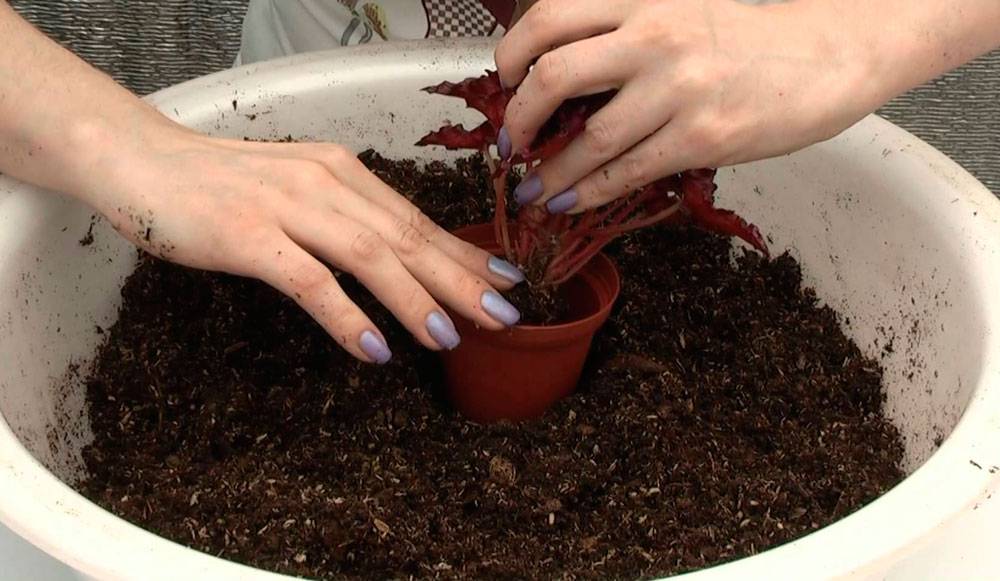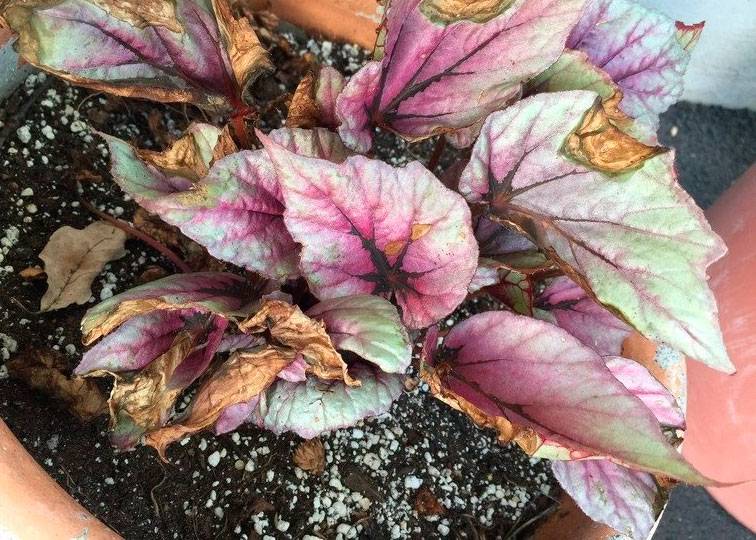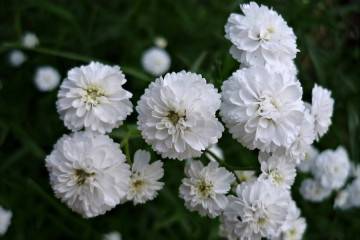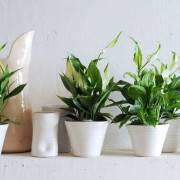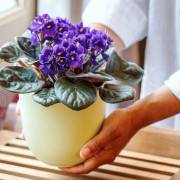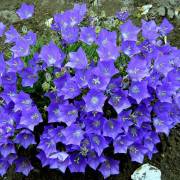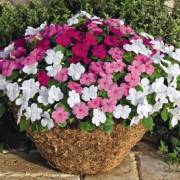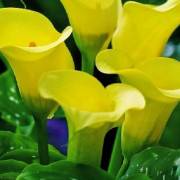Royal begonia - planting and care at home
Content:
Perennial herbaceous shrub begonia (begonia) belongs to the genus of plants of the Begonia family. Royal begonia (begonia Rex) is a representative of this family.
Exotic beauty
The plant deservedly bears the name "royal". Its luxurious large leaves with jagged edges and long stems stand out for their bright color. Depending on the variety, it may have blotches of raspberry, red, silver or purple stripes. They resemble elephant ears or a slightly distorted heart in shape.
Popular varieties
Among the variety of varieties of Royal begonias, the most popular and widespread begonia are Escargot, Griffin, Dark Mambo and Mary Christmas.
Escargot. The spirally curled leaves with a silvery line in the middle resemble a seashell.
Griffin. Large foliage with a carved border is painted in pink and green.
Dark Mambo (dark mambo begonia). The color of the leaves is olive and dark olive. The center of each plate is decorated with a star-shaped spot.
Mary Christmas. The variegated foliage of this plant has the brightest combination of colors in color - from bright pink to green and brown. At the edges, the color becomes burgundy.
The healing effect of the plant
Begonia Royal has a number of qualities beneficial to human health:
- can be used as an antiseptic for the healing of abrasions, scratches;
- reduces motor activity and smooth muscle tone in order to suppress muscle spasm.
Begonia extract is a part of medicines to stimulate blood circulation. Begonia-based preparations treat burns and ulcers.
How royal begonia came to be
This marvelous flower was found on Indian soil in 1856. The find immediately attracted the interest of breeders from different countries. The flowers, taken from the usual subtropical and tropical climate, were first planted exclusively in greenhouses, creating suitable conditions. Over the years, specialists in plant breeding and improvement have created a variety that is more resistant to an unusual atmosphere. Thanks to this transformation, begonias began to be kept indoors in pots on window sills and flower stands for house plants. She even began to decorate garden beds and flower beds.
Features of caring for a flower at home
Royal begonia can be called an unpretentious domestic soil dweller. Even a novice florist can take care of her. A few simple recommendations will help with this.
Temperature regime
The air in a room with flowers of this type should not get very hot. Let's say the range is fifteen to twenty degrees. Overheating and through wind can destroy the plant.
From late spring to the onset of autumn, begonia is taken out into the open air (balcony, terrace).
Lighting
Sunlight and access to it is necessary for the bright color and color saturation of the foliage. He must act in a balanced way. An overabundance threatens the appearance of burns on the deciduous plate, and their twisting. Weak lighting will deprive the plant of its tone and elasticity.
Watering
Water is the main source of food for the flower. The main thing is moderation. Watering is necessary when the top layer of the earth in the container dries up. The liquid should not sit in the sump.
Humidity level
To maintain moisture, a container with water is left next to the flower pot. Large begonia leaves are wiped with a cotton pad moistened with settled water.
Soil selection
It is necessary to prepare the soil or choose a ready-made mixture for planting very carefully. It affects the quality of flower nutrition and the formation of the root system. The roots of this plant are weak. Therefore, we need a loose (water and oxygen permeable), nutritious soil. The mixture should include:
- deciduous humus;
- peat mass;
- vegetable humus;
- sand.
A drain is placed at the bottom of the pot to control soil moisture.
Nutrients
Begonia Royal is fed once or twice a month. Fertilizer with potassium and phosphorus in the composition is suitable. These substances contribute to the early maturation and strengthening of plants.
Bloom
Begonia Rex amazes with the catchy and enchanting appearance of its leaves. And the flowers during the flowering period will not impress. They are pale and small in appearance. Consist of several petals. Florists often remove the buds of flowers so as not to deprive the plant of additional nutrition.
From late autumn to March, the flower plunges into a state of dormancy, stopping blooming. During this period, caring for the Royal Begonia is minimized. Watering is reduced to once a week.
Pruning
The formation of the plant begins in the early stages of growth, when the length of the sprout reaches six to eight centimeters. The upper part is cut off with a sharp cutting tool. This activates the growth of side shoots. Watering is temporarily reduced.
The lateral stems that have grown up to ten centimeters are shortened again, but so as not to hurt the kidney.
Reproduction
Royal begonias have several breeding methods:
- seeds. The sowing period is from September to January. The seeds are superficially immersed in containers with soil, sprayed with water and covered with foil. The seedlings are regularly ventilated. After the sprouts appear, the containers are removed to a lighted cool place;
- cuttings. Shoots of ten to fifteen centimeters with several leaves are cut from the main plant. The leaves are shortened by a third and, after the slices have dried, the cuttings are immersed in a liquid that stimulates growth. Then they are planted in the ground;
- separation of roots. The flower is carefully removed from the pot. The roots are washed, after which they are divided into several parts so that each of them remains with a shoot or bud. After processing the sections with an antiseptic, all segments are placed in separate containers with prepared soil;
- sheet. A large leaf without signs of disease is divided into several parts. Then all parts are planted at an angle into a mixture of volcanic rock with humus of marsh plants, and covered with polyethylene. Rooting takes place within thirty days;
- air layering. The trunk is cut obliquely to the middle of the thickness. A plastic or wooden plate is inserted into the incision so that re-fusion does not occur. The incision is closed with a plastic bag and secured on both sides. The roots will appear in about a month.
Transfer
Transplanting is a mandatory step in plant care. Thanks to her, rejuvenation occurs. You need to do it every three to four years. You will need a fresh soil mixture.You can cook it yourself or buy it ready-made in a specialized store. Fresh soil should include leaf and sod soil, peat mixture and sand (preferably river), in a ratio of 2: 1: 1: 1, respectively. For nourishment, you can add a little pine bark or deciduous humus.
The bottom of the container chosen for transplantation is traditionally filled with drainage.
Diseases and other troubles of royal begonia
There are several diseases that affect begonia more often than others.
Gray rot. Due to excessive humidity in the air or soil, conidia and sclerotia multiply. They are the ones that cause illness. An external sign is softened leaves.
Downy mildew - caused by a dangerous pathogenic fungus. It is also the result of waterlogging. Yellow spots are formed on the foliage.
In addition to diseases, small pests are also a threat.
Bubbles (thrips). Due to their parasitism, multi-colored spots are formed on the foliage.
Mealybug. Fallen leaves will indicate the presence of this insect.
To get rid of small parasites and the consequences of diseases, plants are treated with special solutions. In case of complications, several transplants may be required.
Among other problems in begonia care, it happens that the tips of the leaves dry out. This is due to insufficient lighting. For the same reason, foliage can turn pale. If the plant sheds the buds that have appeared, then it is too hot and needs to be moved to a cool place.
Signs and superstitions
Begonia Royal, according to popular belief, is considered a talisman that brings good luck and creates a favorable atmosphere in the house. But in order for the plant to bring good luck, it needs to be given warmth and care.
Begonia Royal is a popular variety that has a beautiful flowering. To grow a healthy plant, you need to follow the care instructions. Begonia needs certain conditions, without which it cannot bloom.
